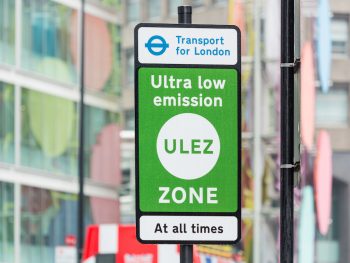The Mayor of London is asking TfL to consult on expanding the Ultra Low Emission Zone London-wide in 2023 to make the capital greener and less congested.

Sadiq Khan has announced the plans today in a keynote speech in Lewisham, responding to overwhelming evidence showing further bold measures are required to reduce toxic air pollution, tackle the climate emergency and cut congestion in the capital.
New analysis by City Hall published last month showed that, despite recent improvements in air quality, every hospital, medical centre and care home across the capital is located in areas that breach latest World Health Organization’s guidelines for nitrogen dioxide and particulate matter.
Meanwhile, this week has seen the UN’s Intergovernmental Panel on Climate Change (IPCC) release a report that warned there is only a brief and rapidly closing window to tackle the climate crisis, with a warning of the dire consequences of inaction.
And a report published in January 2022 revealed that car traffic must reduce by at least 27% in the capital by the end of the decade to meet net-zero by 2030. Separate analysis shows vehicle congestion cost the capital £5.1bn last year, which has risen close to pre-pandemic levels, leading to gridlocked traffic and filthy air pollution.
To tackle these challenges, the capital will have to see a significant shift away from petrol and diesel vehicle use and towards active travel, greater public transport use and cleaner vehicles.
While the Mayor has already said, and reiterated today, that the long-term and fairest solution to these challenges will ultimately be smart road user charging – which TfL has already been asked to explore – bold action is needed in the short term and the Mayor asked TfL last year to present him with a range of policy options that could be taken forward quickly.
These included introducing a Greater London Boundary Charge for vehicles driving into London, implementing a low-level daily Clean Air Charge for all but the cleanest vehicles, and extending the Ultra Low Emission Zone to cover the whole of Greater London.
Based on evidence, the Mayor has decided his preferred option is to extend the Ultra Low Emission Zone London-wide to the London LEZ boundary in 2023, subject to a public and stakeholder consultation. He has ruled out both the Clean Air Charge and the Greater London Boundary Charge as options.
Early assessments indicate that making the ULEZ London-wide would reduce NOx emissions from cars and vans by between 285 and 330 tonnes, and lead to a reduction of around 10% NOx in emissions from cars and vans in outer London. This would build on the 30% reduction in road transport NOx emissions expected from the expanded ULEZ and tighter Low Emission Zone standards.
A London-wide scheme would also reduce CO2 emissions in outer London by between 135,000 to 150,000 tonnes, and cut the number of the most polluting cars on London’s roads by between an additional 20,000 and 40,000 a day.
Sadiq Khan said: “We have too often seen measures delayed around the world because it’s viewed as being too hard or politically inconvenient, but I’m not willing to put off action we have the ability to implement here in London.
“In weighing up the different options, the rising cost of living was a key consideration for me. Because at a time when people’s budgets are under pressure, I’m not willing to ask people to pay more unless I’m absolutely convinced it’s justified to save lives and protect the health of Londoners. I believe the proposal to extend the ULEZ London-wide will have the biggest effect on emissions and congestion relative to the potential financial impact on Londoners as a whole. We are also proposing to introduce the biggest scrappage scheme feasible to help Londoners on low incomes, disabled Londoners and businesses.”
Khan has also called on the Government to provide extra support for such a scrappage scheme in London – as with other cities around the country.
Christina Calderato, director of transport strategy and policy at Transport for London, said: “The world-leading road user charging schemes we’ve delivered throughout the last two decades have been really effective, but it is clear that as a city we need to go further. We know that Londoners understand the Ultra Low Emission Zone, and expanding it to cover all roads and bring the area in line with the Low Emission Zone (LEZ) will be hugely beneficial for improving air quality across the whole city. We look forward to further developing the scheme through formal and comprehensive public consultation later this year.”
The announcement was welcomed by Nick Bowes, chief executive at think tank Centre for London, who said it was another step forward for cleaner air in the city.
“To make it fair for all Londoners, it needs to be accompanied by measures to improve public transport in outer London and help the least well off who’ll be hit the hardest,” he added.
“However this must only be a short-term stepping stone to a smarter pay per mile road user charging scheme, something Centre for London has advocated for a number of years. This will be the truly transformational change that will be able to tackle congestion, promote active travel, clean up the city’s air and provide funding for TfL to invest in public transport.”

